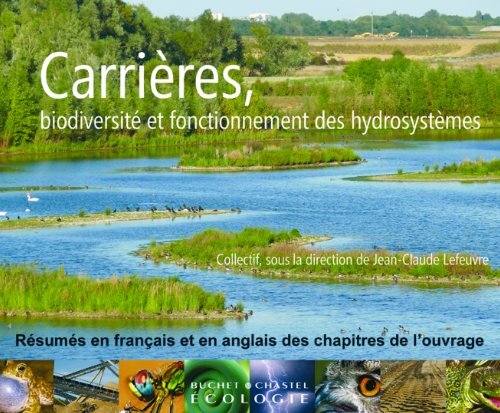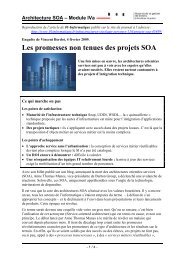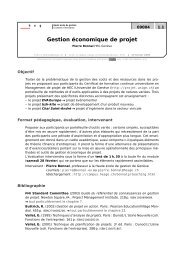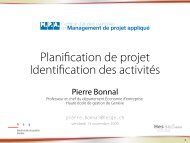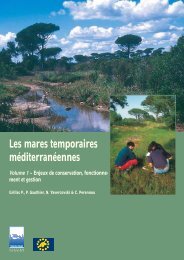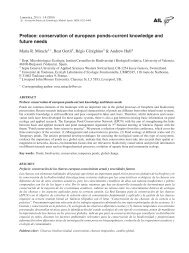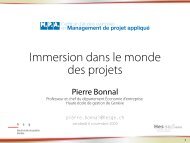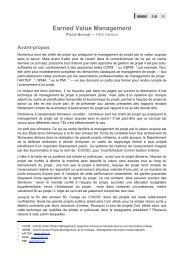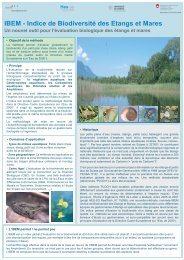carrières, biodiversité - Haute école du paysage, d'ingénierie et d ...
carrières, biodiversité - Haute école du paysage, d'ingénierie et d ...
carrières, biodiversité - Haute école du paysage, d'ingénierie et d ...
Create successful ePaper yourself
Turn your PDF publications into a flip-book with our unique Google optimized e-Paper software.
CARRIÈRES, BIODIVERSITÉ<br />
ET FONCTIONNEMENT DES HYDROSYSTÈMES<br />
<br />
I. LES CARRIÈRES, DES ESPACES EN DEVENIR,<br />
UNE SECONDE VIE POUR LES CARRIÈRES<br />
Les auteurs, sous la direction de Jean-Claude Lefeuvre<br />
Angélie Baral<br />
Phil Benstead<br />
Philippe Dasnias<br />
Pierre Donnadieu<br />
Jean-Pierre Dufay<br />
Charlotte Dumas de Rauly<br />
Ludovic Faytre<br />
Paula Kahumbu<br />
Jean-Christophe Kovacs<br />
Esteve Serra Rodriguez<br />
Volker Stein<br />
II. LES CARRIÈRES ET L’HYDROSYSTÈME<br />
Aicha Amezal<br />
Hocine Bendjoudi<br />
Jean-Paul Bravard<br />
Éliane Fustec<br />
Élisab<strong>et</strong>h Lambert-Servien<br />
Jean-René Malavoi<br />
Ghislain de Marsily<br />
Serge Müller<br />
Pierre-Alain Roche<br />
Gabrielle Thiébaut<br />
Reinhart Traub<br />
Michèle Trémollières<br />
Lothaire Zilliox<br />
III. LES CARRIÈRES ET LE PATRIMOINE NATUREL<br />
Philippe Dasnias<br />
Bernard Frochot<br />
Pierre Joly<br />
Jean-Christophe Kovacs<br />
Jean-Philippe Sibl<strong>et</strong><br />
IV. LES CARRIÈRES, DES ÉCOSYSTÈMES<br />
FONCTIONNELS ET DYNAMIQUES ?<br />
Claude Amoros<br />
Andrea Bertolo<br />
Philippe Boët<br />
Gudrun Born<strong>et</strong>te<br />
Bernard Frochot<br />
Gérard Lacroix<br />
William J. Mitsch<br />
V. UTILISATION, GESTION ET RÉAPPROPRIATION<br />
DES CARRIÈRES POUR L’ENVIRONNEMENT<br />
Andrea Bertolo<br />
Raymond Faure<br />
Francesco Giro<br />
Gérard Lacroix<br />
Christian Lévêque<br />
Jean-Louis Michelot<br />
André Ulmer
LE PROFESSEUR BOURLIÈRE, l’un des pères fondateurs de<br />
l’écologie en France, écrivait dans la préface de L’Écologie (1965), l’un<br />
des tout premiers livres consacrés à c<strong>et</strong>te science dans notre pays :<br />
« l’homme ne peut se passer de la nature <strong>et</strong> vivre en dehors de ses lois.<br />
Est-il besoin de rappeler que notre survie dépend toujours, au siècle<br />
de l’atome comme à ceux de la pierre taillée, de l’absorption quotidienne<br />
d’aliments pro<strong>du</strong>its par le règne végétal <strong>et</strong> par le règne animal. »<br />
Et il ajoutait, plus loin : « Mais il y a plus. L’homme de l’ère in<strong>du</strong>strielle<br />
a mis au point des appareils <strong>et</strong> des techniques qui lui perm<strong>et</strong>tent<br />
non seulement de transformer son milieu comme il ne l’avait jamais fait<br />
auparavant, mais aussi de créer de toute pièce des habitats entièrement<br />
artificiels. Parmi ces derniers, l’un des plus particuliers est le monde <strong>du</strong><br />
béton <strong>et</strong> de l’acier... ».<br />
Entre la pierre taillée <strong>et</strong> le béton, une histoire de près de 2,7<br />
millions d’années s’est écoulée, période au cours de laquelle la roche a<br />
d’abord été utilisée pour accéder à la nourriture (broyage des végétaux,<br />
armes de chasse), avant d’être employée dans la construction des abris,<br />
de servir d’habitat (grotte) puis d’être extraite <strong>et</strong> taillée pour construire<br />
villes <strong>et</strong> villages, d’être transformée pour fournir des mortiers <strong>et</strong> finalement<br />
<strong>du</strong> béton. De même que la chasse <strong>et</strong> la cueill<strong>et</strong>te ont en grande partie<br />
cédé le pas à l’agriculture, la roche, élément le plus emblématique de la<br />
construction de logements ayant permis l’extension vers les pays tempérés<br />
des populations humaines,d’abord «cueillie», a ensuite été extraite<br />
pour, plus tard, donner lieu à une in<strong>du</strong>strie de transformation, celle<br />
<strong>du</strong> béton, s’appuyant obligatoirement sur les ressources provenant de<br />
INTRODUCTION GÉNÉRALE<br />
JEAN-CLAUDE LEFEUVRE<br />
l’extraction de granulats issus de roches massives ou d’alluvions.<br />
Notre progression démographique exponentielle, se tra<strong>du</strong>isant par<br />
une augmentation sans précédent de nos besoins, a entraîné <strong>du</strong> côté<br />
alimentaire une extension considérable des terres agricoles au détriment<br />
des écosystèmes autochtones. De même, la couverture de nos<br />
besoins pour l’habitat <strong>et</strong> l’aménagement <strong>du</strong> territoire (voirie, tunnels,<br />
via<strong>du</strong>cs, barrages,...) a contraint à multiplier les lieux de prélèvements<br />
de matériaux issus de la croûte terrestre, avec des incidences certaines<br />
tant sur la géomorphologie, l’hydrodynamisme, les <strong>paysage</strong>s que sur<br />
le fonctionnement des écosystèmes. Ces derniers, clé de voûte d’une<br />
biosphère pérenne, assurant le maintien de la vie <strong>et</strong> rendant d’immenses<br />
services gratuits à l’humanité depuis son origine, se doivent d’être réhabilités,<br />
restaurés après les agressions temporaires que constituent les<br />
extractions.<br />
Il est plus que temps de porter un véritable diagnostic sur les pertes<br />
de fonctions que subissent certains écosystèmes ainsi que sur les restaurations<br />
entreprises afin d’améliorer un savoir-faire qui perm<strong>et</strong>te de<br />
minimiser les risques liés à l’exploitation des roches <strong>et</strong> granulats.L’objectif<br />
est de réhabiliter des fonctions disparues <strong>et</strong> de compenser certaines<br />
pertes en construisant de nouveaux écosystèmes. L’enjeu devient primordial<br />
en terme de maintien de la <strong>biodiversité</strong> soumise à une sixième crise<br />
<strong>du</strong> fait, pour la première fois dans l’histoire de la vie, des activités<br />
déployées par une seule espèce, la nôtre.<br />
Dans c<strong>et</strong>te perspective, le présent ouvrage témoigne, sur la base de<br />
suivis scientifiques à long terme réalisés tant en France qu’à l’étranger,
4 CARRIÈRES, BIODIVERSITÉET FONCTIONNEMENT DES HYDROSYSTÈMES<br />
des progrès réalisés dans la remise en état <strong>et</strong> dans la cicatrisation<br />
assistée des milieux perturbés par l’extraction. Il fait également le<br />
point sur la qualité des restaurations, vue essentiellement à partir de<br />
diagnostics portés sur l’état de la <strong>biodiversité</strong> <strong>et</strong> des <strong>paysage</strong>s quelques<br />
décennies après les opérations de réhabilitation des sites. Utilisant les<br />
connaissances nouvelles tant dans le domaine de l’hydraulique que<br />
de la <strong>biodiversité</strong> <strong>et</strong> <strong>du</strong> fonctionnement global des hydrosystèmes fluviaux,<br />
c<strong>et</strong> ouvrage développe l’idée de restaurer les fonctions disparues<br />
ou les services ren<strong>du</strong>s, voire d’en créer de nouveaux en favorisant<br />
l’essor dans notre pays d’une véritable « ingénierie écologique ». Il<br />
oblige de ce fait à intégrer « les espaces d’extraction » dans un contexte<br />
beaucoup plus large, tenant compte des échanges intersystèmes <strong>et</strong> des<br />
activités humaines qui se déroulent sur les territoires concernés.<br />
Considérées comme des espaces « en devenir », les <strong>carrières</strong> peuvent<br />
s’intégrer dans les nouvelles politiques d’aménagement <strong>du</strong> territoire<br />
dès lors qu’une stratégie de restauration est conçue à une<br />
échelle territoriale pertinente, tenant compte des besoins des hommes<br />
<strong>et</strong> contribuant ainsi au bien-être des populations locales, informées<br />
<strong>et</strong> conscientes de « l’espace de liberté » qui leur est accordé.<br />
© UNICEM/Pierre-Yves Brunaud<br />
P<br />
ROFESSOR BOURLIÈRE, one of the founding fathers of ecology in<br />
France, wrote in the foreword of L’Écologie (1965), one of the very first<br />
books devoted to this science in our country: “Humanity cannot do without nature<br />
and cannot live apart from its laws. Whatever Throughout the centuries, from<br />
those of the palaeolithicPalaeolithic age to the one ofthat of the atom, we have<br />
toshould remind remember that our survival has always depended on the daily<br />
absorption of food pro<strong>du</strong>ced by the plant and animal kingdoms”. And he added<br />
further: “But there is more. Man of the in<strong>du</strong>strial age has developed equipment<br />
and techniques that allow him not only to transform his environment as he had<br />
never done before, but also to create some entirely artificial habitats. Among them,<br />
one of the most special is the world of concr<strong>et</strong>e and steel ....”.<br />
B<strong>et</strong>ween the cut stone and the concr<strong>et</strong>e, a history of almost 2.7 million years<br />
elapsed, a period <strong>du</strong>ring which the rock was first used for access to food (crushing<br />
of plants, hunting weapons), before being employed in the construction of shelters,<br />
to be used as habitat (cave) then to be extracted and cut to build cities and<br />
villages, to be transformed to provide mortars and finally concr<strong>et</strong>e. Just as<br />
hunting and gathering have largely given way to agriculture, the rock – the most<br />
emblematic element of housing construction which allowed the expansion into<br />
temperate countries of human populations – initially “picked up”, was then<br />
extracted, tofor later give rise to a processing in<strong>du</strong>stry, that of the concr<strong>et</strong>e, based<br />
on resources coming from the aggregate extraction resulting from massive rocks<br />
or alluvia.<br />
Our exponential population growth resulting in an unprecedented increase<br />
in our needs, involved, from a trophic viewpoint, a considerable extension expansion<br />
of farmland to the d<strong>et</strong>riment of native ecosystems. In the same way the cover<br />
satisfaction of our needs for the habitathousing and country land-use planning<br />
(roadway system, tunnels, via<strong>du</strong>cts, dams,…) has constrained made it necessary<br />
to multiply the sampling places facilities of for materials from the earth’s<br />
crust, with unquestionable incidences not only on the geomorphology, the hydrodynamism<br />
and, the landscapes, but also on ecosystem functioning. The latter,
CARRIÈRES, BIODIVERSITÉET FONCTIONNEMENT DES HYDROSYSTÈMES 5<br />
which isbeing the keystone of a perennial biosphere through the maintenance of life<br />
and the supply provision of immense services – free of charge - to humanity since<br />
its origin, must be rehabilitated and restored after the temporary aggressions that<br />
are the extractions constitute.<br />
It is high time to make a true diagnosis on the losses of functions which<br />
some ecosystems undergo as on the restorations carried out in order to improve<br />
a know-how which makes it possible to minimize risks related to the exploitation<br />
of rocks and aggregates. The objective is to rehabilitate disappeared functions<br />
and to compensate for certain losses by building new ecosystems. This<br />
challengee stake is becoming of paramount importance for the maintenance of<br />
biodiversity, which is presently subjected tocurrently undergoing a sixth extinction<br />
crisis caused, for the first time in the history of life, by the activities deployed<br />
by only one species, ours.<br />
From this point of view, this volume shows, on the basis of long-term scientific<br />
monitoring carried out both in France and abroad, the progress made in the rehabilitation<br />
and in the assisted healing of the environments disturbed by the<br />
extraction. It also provided provides an update on the quality of restorations,<br />
mainly seen from diagnoses on the state of the biodiversity and the landscapes<br />
a few decades after the rehabilitation operations of the sites’ rehabilitation. Based<br />
on the most recent insights both in the fields of hydraulics on the one hand and<br />
of biodiversity and global functioning of fluvial hydrosystems on the other, this<br />
book develops the idea of restoring missing functions or services, or even creating<br />
new ones by promoting in our country a true “ecological engineering”.<br />
ConsequentlyTherfore, it requires integratingleads us to consider “the areas of<br />
extraction” in a much broader context, taking into account intersystems exchanges<br />
and human activities, which proceedestablished in our the concerned territories.<br />
Considered as spaces “constantly evolving”, environments, careers<br />
quarries can be integrated into new regional planning policies, since provided<br />
that thea restoration strategy is designed on a relevant territorial scale,<br />
and that it takestaking human needs into account, of human needs and thus<br />
contributing to the well-being of the local populations, who are informed and<br />
aware of “the space area of freedom” which that is granted to them.<br />
© Jean-Claude Lefeuvre
L’UTILISATION DES CARRIÈRES<br />
APRÈS EXPLOITATION :<br />
ANALYSE DE QUELQUES EXEMPLES EUROPÉENS<br />
Jean-Christophe Kovacs, Philippe Dasnias <strong>et</strong> Angélie Baral<br />
Ecosphère<br />
I. LES CARRIÈRES, DES ESPACES EN DEVENIR,<br />
UNE SECONDE VIE POUR LES CARRIÈRES<br />
Mots clés : aménagement écologique, expertise écologique, gravières,<br />
plans d’eau, zones humides<br />
Débutée modestement <strong>et</strong> portant initialement essentiellement sur l’avifaune,<br />
l’étude écologique des <strong>carrières</strong> a pris de l’ampleur ces dernières<br />
années pour prendre en compte l’ensemble des aspects<br />
écosystémiques.<br />
Néanmoins, il subsiste encore un fossé entre la théorie – ce qui est<br />
préconisé – <strong>et</strong> la réalité de ce qui a été fait jusqu’à présent. Il est vrai<br />
que ces dernières années, de nombreux plans de réaménagement écologique,<br />
dont certains très ambitieux, ont été déposés avec les études<br />
d’impact (ou leurs équivalents à l’étranger) <strong>et</strong> que les créations de zones<br />
humides sur des gravières vont se multiplier dans les années à venir.<br />
Keywords : ecological planning, ecological expertise, gravel pits, open waters,<br />
w<strong>et</strong>lands<br />
With a modest start and initially focussing on bird species, the ecological study<br />
of quarries has greatly widened its horizon for the past few years, now taking<br />
into account all ecosystemic aspects. However, there is still a gap b<strong>et</strong>ween theory<br />
– what is recommended – and reality with the work carried out so far. It is<br />
true, though, that for the past few years, numerous ecological rehabilitation plans<br />
– some being fairly ambitious, have been registered along with impact assessments,<br />
and that w<strong>et</strong>land creation in quarries is going to increase for the coming<br />
years.<br />
EN ALLEMAGNE : ÉTUDES DE CAS<br />
Volker Stein<br />
Mots clefs : avifaune, <strong>biodiversité</strong>, dynamique végétale, gravières,<br />
réaménagement des <strong>carrières</strong> en Allemagne<br />
© GSM Lorraine
CARRIÈRES, BIODIVERSITÉET FONCTIONNEMENT DES HYDROSYSTÈMES 7<br />
Forte d’une expérience de plus de 25 ans en restauration écologique<br />
des <strong>carrières</strong> <strong>et</strong> des mines, l’Allemagne obtient aujourd’hui des résultats<br />
plus qu’encourageants. Des habitats de qualité ont été créés pour<br />
la faune <strong>et</strong> la flore sauvage. Ces milieux ont constitué des habitats de<br />
substitution pour certaines espèces végétales <strong>et</strong> animales rares <strong>et</strong><br />
menacées, notamment pour diverses orchidées, le castor, le héron<br />
pourpré, la sterne pierregarin, le sonneur à ventre jaune… Dans de<br />
nombreux cas, ces nouveaux habitats s’intègrent parfaitement dans<br />
le <strong>paysage</strong> environnant. Néanmoins, il est recommandé de planifier<br />
ce territoire sur un périmètre suffisamment large pour éviter les aménagements<br />
à p<strong>et</strong>ite échelle, notamment pour les plans d’eau. Notre<br />
expérience nous a montré que ceux-ci sont rapidement envahis par<br />
la végétation.<br />
Keywords: bird species, biodiversity, flora dynamics, gravel quarries, quarry<br />
rehabilitation in Germany<br />
© Ecosphère/Michel Pajard<br />
Germany has now more than 25 years of experience with the ecological restoration<br />
of pits and quarries. We have attained satisfying and encouraging results.<br />
Adequate habitats for endangered plants and wildlife have been created. Such<br />
surroundings have generated substitute habitats for some rare and threatened<br />
flora and fauna species, in particular various orchid species, the beaver, the Purple<br />
Heron, the Common Tern, the Yellow bellied toad… In many cases, these<br />
new habitats are well integrated in the surrounding landscape.<br />
However, we recommend planning such area on a large-scale basis so<br />
as to avoid small-scale infrastructures, especially for water works. In<br />
our experience such infrastructures will be very fast overgrown by<br />
veg<strong>et</strong>ation.<br />
EN ESPAGNE :<br />
LE TRAITEMENT ET LA GESTION<br />
DU RÉAMÉNAGEMENT<br />
DE L’ENVIRONNEMENT APRÈS EXPLOITATION<br />
DES CARRIÈRES À CIEL OUVERT EN CATALOGNE<br />
Esteve Serra Rodriguez<br />
Directeur de la section de réaménagement de <strong>carrières</strong>, Département de<br />
l’Environnement, Gouvernement autonome de Catalogne<br />
Mots clés : <strong>carrières</strong>, législation des <strong>carrières</strong>, recyclage des déch<strong>et</strong>s,<br />
réaménagement des <strong>carrières</strong> en Catalogne<br />
L’impact environnemental lié à l’extraction de matériaux est considérable,<br />
affectant notamment la morphologie <strong>du</strong> terrain en endommageant la structure<br />
fonctionnelle des écosystèmes <strong>et</strong> l’esthétique <strong>du</strong> <strong>paysage</strong>. Il faut<br />
attendre 1981 pour que naisse le premier texte légal espagnol en matière<br />
de protection <strong>et</strong> de réaménagement environnemental s’appliquant aux<br />
<strong>carrières</strong> superficielles.
8 CARRIÈRES, BIODIVERSITÉET FONCTIONNEMENT DES HYDROSYSTÈMES<br />
Une caractéristique remarquable de c<strong>et</strong>te loi est la garantie financière<br />
incluse, soit une somme que doit déposer l’exploitant pour<br />
assurer l’exécution de la totalité des mesures de protection environnementales<br />
– travaux de restauration des habitats inclus – condition<br />
sine qua non pour obtenir l’autorisation ou la concession d’activités<br />
minières. Toutes demandes de recherche ou d’exploitation étant obligatoirement<br />
accompagnées par un programme de réaménagement, le<br />
remboursement de la garantie dépend de la réalisation des travaux prévus<br />
dans ce cadre.<br />
La prise en charge de ces éléments par les divers acteurs a permis<br />
de les intégrer progressivement dans les habitudes de travail <strong>et</strong> a<br />
con<strong>du</strong>it notamment à l’intro<strong>du</strong>ction <strong>du</strong> concept de restauration intégrée.<br />
Celle-ci consiste, entre autres, à profiter des matériaux extraits<br />
de l’exploitation pour combler <strong>et</strong> restaurer morphologiquement les secteurs<br />
d’exploitation déjà épuisés. L’utilisation <strong>et</strong> le recyclage de divers<br />
types de matériaux secondaires sont encouragés pour les travaux de<br />
restauration environnementale (incluant les boues d’épuration, mais<br />
aussi le recyclage de déch<strong>et</strong>s extérieurs comme le lisier d’exploitations<br />
porcines).<br />
Le type de réaménagement obligé <strong>et</strong> garanti ainsi appliqué en<br />
Catalogne assure une bonne restauration écologique puisqu’il main-<br />
Tous droits réservés<br />
tient ou crée des habitats, contribuant à la <strong>biodiversité</strong> locale. Chaque<br />
année en Catalogne, quelque 500 ha de <strong>carrières</strong> à ciel ouvert sont<br />
réaménagés, facilitant ainsi l’intégration de ces nouveaux habitats<br />
dans leur environnement, conformément à la réglementation<br />
environnementale.<br />
Key words : quarries, quarry legislation, quarry rehabilitation in Catalonia,<br />
waste recycling<br />
The environmental impact related to material extraction is considerable, particularly<br />
affecting land morphology by altering the functional structure of<br />
ecosystems and their aesth<strong>et</strong>ics. It was only in 1981 that the first Spanish legal<br />
act on open quarry environmental protection and rehabilitation was drafted.<br />
A remarkable characteristic of this law is the financial guarantee integrated,<br />
i.e. an amount which the operator deposits to ensure the full implementation of<br />
all environmental protection measures – including habitat restoration –<br />
a prerequisite to obtain an operation permit. As a rehabilitation programme<br />
has to accompany such request, the reimbursement of the guarantee depends on<br />
the achievement of measures planed in this framework.<br />
As various stakeholders were taking these elements into consideration, they<br />
were progressively integrated in their working habits, leading notably to the<br />
intro<strong>du</strong>ction of the integrated restoration concept. It consists of, among others,<br />
using extracted material to fill and restore the morphology of old quarry<br />
sectors.<br />
The use and recycling of various secondary types of material are also<br />
encouraged for environmental restoration work (including sewage sludge, y<strong>et</strong><br />
also the recycling of external waste such as swine manure).This type of mandatory<br />
and guaranteed rehabilitation has been successfully applied in Catalonia,<br />
ensuring a good ecological restoration as it maintains or creates habitats, thus<br />
contributing to the local biodiversity. Each year in Catalonia, some 500 ha of
open quarries are being rehabilitated, thus facilitating the integration of these<br />
new habitats into their surrounding, in conformity with the environmental<br />
legislation.<br />
EN GRANDE-BRETAGNE<br />
Phil Benstead<br />
W<strong>et</strong>lands Project Officer<br />
The Royal Soci<strong>et</strong>y for the Protection of Birds, UK<br />
CARRIÈRES, BIODIVERSITÉ ET FONCTIONNEMENT DES HYDROSYSTÈMES 9<br />
Mots clés : dynamique de végétation, gestion des <strong>carrières</strong>, gravières,<br />
partenariats exploitants / association de conservation de la nature,<br />
réaménagement des <strong>carrières</strong> en Grande-Br<strong>et</strong>agne<br />
Si les <strong>carrières</strong> de graviers jouent un rôle important pour la <strong>biodiversité</strong><br />
des milieux humides, la majorité des habitats ainsi créés<br />
l’ont été accidentellement <strong>et</strong> peu de sites ont ensuite été gérés de<br />
façon optimale. Dès les années 1980, des spécifications techniques<br />
sont alors élaborées au Royaume-Uni pour optimiser c<strong>et</strong>te gestion<br />
des sites. Ainsi, les proj<strong>et</strong>s de création d’habitats sont souvent<br />
confiés à des organismes bénévoles de conservation de la nature<br />
se chargeant de ce travail, les exploitants s’engageant à respecter<br />
leurs objectifs (ex. réserve naturelle de Sevenoaks gérée par une<br />
société indépendante).<br />
Depuis l’élaboration des Plans d’actions habitat intro<strong>du</strong>its par le<br />
gouvernement, l’accent a été mis sur la conservation de la <strong>biodiversité</strong>,<br />
<strong>et</strong> le rôle des in<strong>du</strong>striels pour atteindre ces objectifs est en passe<br />
d’être reconnu, les <strong>carrières</strong> de sables <strong>et</strong> de graviers offrant un fort potentiel<br />
en créant des prairies humides <strong>et</strong> des roselières. De nombreuses<br />
<strong>carrières</strong> encore exploitées telles qu’à Needingworth in Cambs <strong>et</strong><br />
Langford Lowfields, ont été aménagées en partenariats avec des orga-<br />
nismes de conservation afin d’apporter une contribution significative<br />
aux objectifs <strong>du</strong> BAP (Plan d’actions <strong>biodiversité</strong>) concernant<br />
les roselières.<br />
De plus, les processus naturels pour la régularisation des habitats<br />
créés sont de plus en plus intégrés, évitant une coûteuse gestion artificielle<br />
<strong>et</strong> perm<strong>et</strong>tant de restaurer des habitats rares <strong>et</strong> naturels tels que<br />
les forêts alluviales (cas de Milton Keynes).<br />
Keywords : flora dynamics, quarry management, gravel quarries, partnership<br />
mineral company-nature conservation organisation, quarry rehabilitation in the<br />
United Kingdom<br />
Though gravel quarries play an important role for w<strong>et</strong>land biodiversity, most<br />
habitats created in this way were so by mistake and few sites were then<br />
managed in an appropriate way. Since the 80’s, technical specifications were<br />
developed in the United Kingdom to optimize site management. Hence, habitat<br />
creation projects are often assigned to nature conservation charities in charge of<br />
this work, companies binding themselves to respect their objectives (e.g. Sevenoaks<br />
Nature Reserve managed by a trust).<br />
© Ecosphére/Michel Cambroni
10 CARRIÈRES, BIODIVERSITÉ ET FONCTIONNEMENT DES HYDROSYSTÈMES<br />
Since the development of the Habitat Action Plans intro<strong>du</strong>ced by the government,<br />
biodiversity conservation was put forward, and companies’ key role in<br />
achieving this aim is about to be recognised, sand and gravel quarries offering<br />
a huge potential while creating w<strong>et</strong> meadows and reedbeds. Many quarries still<br />
running such as in Needingworth in Cambs and Langford Lowfields have been<br />
planned in partnership with nature conservation organisations so as to<br />
contribute significantly to the BAP’s objectives (Biodiversity Action Plan) on<br />
reedbeds.<br />
Moreover, natural processes for habitats control are more and more integrated,<br />
avoiding a costly artificial management and enabling the restoration of<br />
rare and natural habitats such as floodplain forests (Milton Keynes case study).<br />
DIVERSITÉ DE L’UTILISATION DES CARRIÈRES :<br />
EXEMPLE DE L’ÎLE-DE-FRANCE<br />
Ludovic Faytre <strong>et</strong> Jean-Pierre Dufay<br />
IAURIF - Département environnement urbain <strong>et</strong> rural<br />
Mots clés : aménagement des <strong>carrières</strong> en eau, Bassée, <strong>carrières</strong> en Îlede-France,<br />
gestion <strong>du</strong>rable des ressources en matériaux<br />
Les besoins importants passés <strong>et</strong> présents de l’agglomération parisienne<br />
en matériaux de <strong>carrières</strong>, notamment alluvionnaires, <strong>et</strong> la faiblesse des<br />
ressources franciliennes, ont provoqué depuis longtemps des conflits<br />
d’usages.<br />
Le devenir des <strong>carrières</strong> après exploitation est varié <strong>et</strong> offre des opportunités<br />
intéressantes d’aménagement, en particulier écologiques, qui<br />
furent diversement utilisées par le passé.<br />
Une gestion <strong>du</strong>rable <strong>et</strong> concertée de la ressource en matériaux est<br />
nécessaire pour éviter le mitage de l’espace <strong>et</strong> perm<strong>et</strong>tre la cohérence des<br />
réaménagements <strong>et</strong> des gestions post-exploitation entre les différentes<br />
<strong>carrières</strong>. Pour ce faire, l’échelle <strong>du</strong> gisement est pertinente <strong>et</strong> devra être<br />
intégrée dans les documents d’urbanisme <strong>et</strong> de planification.<br />
Keywords : alluvial quarry rehabilitation, Bassée, quarries in the Ile-de-France<br />
region, material resource sustainable management<br />
The important past and present quarry material needs of the Parisian conurbation<br />
– especially alluvial ones, and the resource scarcity offered by the region<br />
have long led to use conflicts.<br />
The quarry outcome once operations are over is various and offers<br />
interesting planning opportunities, particularly ecological ones, which have not<br />
always been seized in the past.<br />
A sustainable management of material resources agreed upon is necessary<br />
to avoid patches of space, enable some coherence in the rehabilitation work and<br />
a proper ex-post management b<strong>et</strong>ween quarries. In this end, the deposit scale<br />
is important and should be taken into account in planning documents.<br />
Tous droits réservés
CARRIÈRES, BIODIVERSITÉ ET FONCTIONNEMENT DES HYDROSYSTÈMES 11<br />
LE CONCEPT DE DÉVELOPPEMENT DURABLE<br />
APPLIQUÉ AUX CARRIÈRES : LE CAS DE BAMBURI<br />
CEMENT À MOMBASA, KENYA<br />
Paula Kahumbu <strong>et</strong> Charlotte Dumas de Rauly<br />
Lafarge Ecosystems<br />
Mots clés : Bamburi Cement, écosystème forestier tropical, é<strong>du</strong>cation,<br />
Haller Park, réaménagement de carrière calcaire, tourisme, zone<br />
humide<br />
Bamburi Cement (Kenya) compte plusieurs <strong>carrières</strong> calcaires, à différents<br />
stades d’exploitation <strong>et</strong> de réaménagement, les plus vieilles<br />
datant d’une trentaine d’années. L’objectif général <strong>du</strong> réaménagement<br />
est de créer un écosystème de forêts <strong>et</strong> de zones humides<br />
économiquement <strong>et</strong> écologiquement autosuffisant, dans une optique<br />
d’é<strong>du</strong>cation à l’environnement. La plus vieille carrière est devenue<br />
un parc touristique assurant une source de revenus pour les travaux<br />
de réaménagement en cours. Les travaux réalisés tentent de prendre<br />
en compte le concept de développement <strong>du</strong>rable par l’autosuffisance<br />
des écosystèmes créés, l’établissement de zones de loisir <strong>et</strong> de tourisme<br />
dans la région, la génération d’emplois, la pro<strong>du</strong>ction <strong>et</strong> la plantation<br />
d’arbres pour les communautés locales… Quelques difficultés sont<br />
rencontrées, concernant notamment la <strong>du</strong>rabilité écologique (choix<br />
des essences à intro<strong>du</strong>ire, artificialisation de la gestion <strong>du</strong> système aquatique,<br />
…). Cependant c<strong>et</strong> exemple exceptionnel de réaménagement de<br />
<strong>carrières</strong> en zone tropicale africaine joue un rôle important dans<br />
l’é<strong>du</strong>cation <strong>et</strong> la recherche à travers la communication d’un savoirfaire<br />
aux communautés locales, l’é<strong>du</strong>cation environnementale des<br />
enfants, l’opportunité d’études variées <strong>et</strong> bientôt la création d’un<br />
centre environnemental de documentation <strong>et</strong> de recherche.<br />
Keywords : Bamburi Cement, tropical forest ecosystem, e<strong>du</strong>cation, Haller Park,<br />
limestone quarry rehabilitation, tourism, w<strong>et</strong>land<br />
Bamburi Cement (Kenya) owns several limestone quarries, which are at<br />
various stages of excavation and rehabilitation (the first rehabilitation works<br />
started more than 30 years ago).<br />
The main objective of rehabilitation is to create an ecosystem of forest and<br />
w<strong>et</strong>land economically and ecologically self-sufficient as a demonstration for environment<br />
e<strong>du</strong>cation. The oldest quarry has now become a tourist park and is a<br />
source of income for the current rehabilitation works. These works try to fit into<br />
the sustainable development context through the creation of self-sufficient ecosystems,<br />
the creation of leisure and tourist attractions in the region, generating<br />
jobs, tree nursing and plantation for the local communities… Some difficulties<br />
are encountered, in particular concerning the ecological sustainability<br />
(choice of planted species, artificial water system management…). However this<br />
outstanding example of quarry rehabilitation in an African tropical area has<br />
a great significance for research and e<strong>du</strong>cation, through tree planting knowledge<br />
transmission to the local communities, children environment e<strong>du</strong>cation, offering<br />
various study opportunities. In this context, an environment research and<br />
documentation center is being developed.<br />
© Ecosphère/Michel Pajard
LA PRISE EN COMPTE DES<br />
CARRIÈRES ALLUVIONNAIRES DANS LES SDAGE :<br />
EXEMPLE DU BASSIN SEINE-NORMANDIE<br />
Pierre-Alain Roche <strong>et</strong> Aicha Amezal<br />
Agence de l’eau Seine-Normandie<br />
II. LES CARRIÈRES ET L’HYDROSYSTÈME<br />
Mots clés : SDAGE, schéma d’exploitation des <strong>carrières</strong>, zonage,<br />
réaménagement<br />
Les SDAGE, entrés en vigueur en 1997, prévoient une gestion équilibrée<br />
de la ressource en eau, élargie à la gestion des milieux aquatiques<br />
<strong>et</strong> humides. Ils devraient à long terme perm<strong>et</strong>tre de résoudre les<br />
problèmes de qualité <strong>et</strong> de quantité d’eau disponible.<br />
L’un des objectifs <strong>du</strong> SDAGE Seine-Normandie est de rendre<br />
compatible l’extraction de granulats avec la préservation de la ressource<br />
en eau <strong>et</strong> <strong>du</strong> fonctionnement hydrique des zones humides. Localement,<br />
la réalisation de c<strong>et</strong> objectif passe essentiellement par l’élaboration des<br />
schémas départementaux de carrière, prévoyant notamment le<br />
réaménagement des sites à l’échelle de la vallée.<br />
Le schéma seine-<strong>et</strong>-marnais est à ce titre intéressant, en particulier<br />
<strong>du</strong> fait des conflits d’usage sur la Bassée. Il prévoit :<br />
– la ré<strong>du</strong>ction des prélèvements par une sectorisation des gisements<br />
<strong>et</strong> par l’élaboration d’un guide d’utilisation des matériaux ;<br />
– une meilleure remise en état des sites après exploitation, passant<br />
par une plus grande intégration paysagère, un zonage approprié des<br />
travaux de réaménagement ainsi que l’élaboration d’un guide de<br />
remise en état.<br />
Il a con<strong>du</strong>it localement à la mise en place d’une concertation entre<br />
les acteurs sur l’utilisation de l’espace. Les zonages, qui doivent être<br />
affinés, sont précisés dans les documents d’urbanisme. Cependant, en<br />
1999, on n’observait pas un respect systématique des prescriptions <strong>du</strong><br />
SDAGE, mais plus un usage comme « vitrine » ou démonstration de<br />
bonne volonté.<br />
Keywords : water management scheme, quarry exploitation scheme, zoning,<br />
rehabilitation<br />
SDAGE, which came into force in 1997, recommend a appropriate water resource<br />
management for w<strong>et</strong>lands and aquatic ecosystem. On the long term, they should<br />
enable to solve problems related to water quality and quantity available. One<br />
of the objectives of the Seine-Normandie SDAGE is to make gravel extraction possible<br />
while preserving water resource and w<strong>et</strong>lands hydrologic functioning.<br />
Locally, reaching this aim will be achieved by developing district management schemes<br />
for quarries, with the rehabilitation of sites at the valley scale.The Seine-<strong>et</strong>-Marne<br />
scheme is particularly interesting as many use conflicts occur in the la Bassée.<br />
It plans to :<br />
– re<strong>du</strong>ce extractions through a division into sectors of the mineral deposit and<br />
through the development of guidelines on the use of materials<br />
– improve the rehabilitation process of sites after exploitation, through a b<strong>et</strong>ter<br />
integration of the landscape, a appropriate zoning system of rehabilitation<br />
work and the development of guidelines regarding such planning.<br />
The scheme led locally to the s<strong>et</strong>ting in place of a dialogue proce<strong>du</strong>re b<strong>et</strong>ween<br />
stakeholders upon space use. The division into sectors, which has to be further<br />
d<strong>et</strong>ailed, are defined in planning documents. In 1999 however, a systematic
espect of the SDAGE objectives was not to observe, but rather its use was a<br />
demonstration of good will.<br />
LES CARRIÈRES ALLUVIONNAIRES PROFONDES<br />
ET LA DYNAMIQUES DES NAPPES<br />
Reinhart Traub <strong>et</strong> Lothaire Zilliox<br />
CARRIÈRES, BIODIVERSITÉ ET FONCTIONNEMENT DES HYDROSYSTÈMES 13<br />
Institut franco-allemand de recherche sur l’environnement Strasbourg-Karlsruhe<br />
Mots clés : hydrosystème, échanges nappe-carrieres, nappe alluviale<br />
Pour répondre à la problématique de l’eau, une gestion équilibrée des<br />
ressources impose de prendre en compte la globalité de l’hydrosystème.<br />
Dans les vallées fluviales, l’exploitation des granulats dans<br />
les aquifères alluviaux – où le toit de la « nappe phréatique » est proche<br />
<strong>du</strong> sol – est susceptible d’aggraver les risques d’inondations <strong>et</strong> de<br />
pollution.<br />
Or, la dynamique de l’eau dans ces milieux <strong>et</strong> le transport de polluants<br />
sont des phénomènes physiques pouvant être représentés par<br />
des modèles, pour comprendre les mécanismes fondamentaux de<br />
transfert <strong>et</strong> éviter les impacts d’activités humaines. Ils sont de plus en<br />
plus utilisés, bien que nécessitant parfois un nombre élevé de mesures<br />
pour parer à l’hétérogénéité des milieux naturels étudiés, dont le<br />
caractère souterrain rend l’identification des paramètres d’autant plus<br />
difficile.<br />
De plus, en réalisant des analyses isotopiques situant l’âge<br />
d’origine d’eaux profondes de la nappe non contaminée, des informations<br />
supplémentaires fort utiles à la compréhension des mécanismes<br />
réels sont disponibles (âges, constitution des couches d’eau,<br />
cheminements…). Ces informations perm<strong>et</strong>tent d’orienter certaines<br />
décisions pour garantir une gestion <strong>du</strong>rable des eaux sou-<br />
terraines (en garantissant éventuellement leur consommation) <strong>et</strong><br />
par extension, de l’aménagement <strong>du</strong> territoire.<br />
Keywords : hydrosystem, groundwater, groundwater-quarry interactions<br />
In order to respond to the water issue, a sound resource management requires<br />
to take into account the hydrosystem as a whole. In river valleys, aggregate extraction<br />
in les alluvial aquifers – where the surface of the ground water is close to<br />
the land surface, may worsen flooding risks and pollution.<br />
Y<strong>et</strong>, water dynamics in these natural environments and pollutant transport<br />
are physical phenomenon, which may be represented by using mathematical<br />
models, to understand fu5ndamental transfer mechanisms and to avoid impacts<br />
of human activities. There are used more and more often, although they som<strong>et</strong>imes<br />
require a high number of measurements to counteract the h<strong>et</strong>erogeneity of<br />
the studied environment, as those being underground, the identification<br />
of param<strong>et</strong>ers is even more difficult.<br />
Moreover, by performing isotopic analysis assessing the age of deep water<br />
levels at the bottom of the non contaminated ground water, additional<br />
Tous droits réservés
14 CARRIÈRES, BIODIVERSITÉ ET FONCTIONNEMENT DES HYDROSYSTÈMES<br />
information are made available – som<strong>et</strong>hing very useful for the comprehension<br />
of mechanisms on field (age, constitution of water beds, water routes…). This<br />
information helps in making decisions to guarantee a sustainable management<br />
of ground waters (eventually ensuring their drinkability), and by extension, that<br />
of land planning.<br />
LES CARRIÈRES ET L’ESPACE DE LIBERTÉ<br />
DES COURS D’EAU<br />
Jean-Paul Bravard <strong>et</strong> Jean-René Malavoi<br />
Professeur de géographie à l’université de Lyon 2<br />
Ingénieur conseil, professeur associé à la faculté des Sciences de Tours<br />
Mots clés : hydrosystème, espace de liberté, gestion des cours d’eau,<br />
recharge alluviale<br />
L’extraction de granulats jusqu’à la fin des années 1970 a eu de forts<br />
impacts sur le fonctionnement de l’hydrosystème fluvial, entraînant<br />
l’enfoncement des cours d’eau majeurs. Ceci a con<strong>du</strong>it à un changement<br />
de politique reportant les <strong>carrières</strong> dans des bandes riveraines proches<br />
de la rivière.De nouveaux impacts sont apparus avec des modifications<br />
lourdes <strong>et</strong> irréversibles des écosystèmes <strong>du</strong> lit majeur.<br />
Le concept d’espace de liberté a alors été développé pour conserver<br />
sur le long terme c<strong>et</strong>te capacité de recharge alluviale <strong>et</strong> m<strong>et</strong>tre en évidence<br />
l’intérêt des biocénoses riveraines naturelles. C<strong>et</strong>te approche repose sur<br />
une délimitation d’un espace de mobilité fonctionnel (ré<strong>du</strong>ction des<br />
crues, protection de la ressource en eau potable…) variant en fonction<br />
<strong>du</strong> type de cours d’eau. C’est un enjeu majeur de l’aménagement futur<br />
des fonds de vallées.<br />
Keywords : hydrosystem, open space, stream management, alluvial refill<br />
The extraction of aggregates until the end of the 70’s has had lots of negative<br />
impacts on the river hydrosystem functioning, with the deepening of main<br />
water streams. This led to political switch, with the installation of quarries<br />
alongside river channels. New impacts appeared with heavy and irreversible<br />
modifications of the main water stream’s ecosystems.<br />
Consequently, the concept of “open space” was designed to preserve the capacity<br />
on the long term of the alluvial refill and highlight the interest of natural river<br />
biocoenosis.<br />
This approach is based on the delimitation of a functional mobility space<br />
(flood re<strong>du</strong>ction, protection of drinkable water sources…) varying according<br />
to the type of water stream. This is a major issue for the future planning of<br />
river floodplains.<br />
LES CARRIÈRES ET LA QUALITÉ DES EAUX<br />
DES NAPPES ALLUVIALES<br />
Hocine Benjoudi <strong>et</strong> Ghislain de Marsily<br />
UMR Sisyphe, université Paris 6<br />
Mots clefs : nappes alluviales, ruissellement, bilan hydrologique,<br />
processus de r<strong>et</strong>ention, dénitrification, gestion des plaines alluviales<br />
Les zones humides sont des milieux connaissant de fortes variations<br />
spatiales <strong>et</strong> temporelles conférant une <strong>biodiversité</strong> riche, source d’eau<br />
<strong>et</strong> de matières premières, dont les rôles en terme d’épuration <strong>et</strong> de<br />
contrôle <strong>du</strong> régime des eaux sont essentiels. Il est donc fondamental<br />
de comprendre le fonctionnement de ces milieux. Dans le cadre <strong>du</strong><br />
Programme national de recherche sur les zones humides (PNRZH), une<br />
étude pluridisciplinaire a été con<strong>du</strong>ite portant sur la Seine moyenne<br />
<strong>et</strong> s’appuyant sur l’analyse de divers paramètres incluant la fluctuation<br />
<strong>du</strong> niveau d’eau <strong>et</strong> ses dynamiques (circulations, échanges, bilans,
CARRIÈRES, BIODIVERSITÉ ET FONCTIONNEMENT DES HYDROSYSTÈMES 15<br />
modélisation). Le bilan hydrologique pour la zone humide alluviale<br />
seule a montré la nécessité de prendre en compte les eaux souterraines<br />
(d’échelle régionale) dans l’étude de l’hydrologie des zones humides.<br />
En eff<strong>et</strong>, il est largement admis que les zones humides ont une grande<br />
influence sur le transfert des nitrates des nappes aquifères environnantes<br />
vers les cours d’eau.<br />
Les travaux préliminaires ont indiqué une variation assez marquée,<br />
selon les sites <strong>et</strong> les saisons, des teneurs en nitrates. Cela suppose, d’une<br />
part, une contamination par des apports d’origine agricole <strong>et</strong> perm<strong>et</strong><br />
d’envisager l’existence, au sein des gravières, de processus de rétention<br />
(absorption par les végétaux) <strong>et</strong>/ou d’élimination des nitrates<br />
(dénitrification). Ainsi, les milieux étudiés se comportent, dans l’ensemble,<br />
comme des pièges vis-à-vis des éléments intro<strong>du</strong>its par la<br />
nappe. Néanmoins, la présence des gravières modifie les écoulements<br />
souterrains en basses eaux (colmatage <strong>du</strong> fond <strong>et</strong> des parois, présence<br />
<strong>et</strong> texture des remblais) entraînant un déficit d’alimentation de la<br />
nappe alluviale.<br />
Des études plus approfondies sur un ensemble de gravières sont<br />
donc essentielles pour intégrer, au moins en partie, la variabilité fonctionnelle<br />
de ces écosystèmes <strong>et</strong> de leur environnement. Pourtant, suite<br />
Tous droits réservés<br />
à la nouvelle directive européenne sur l’eau, chaque pays doit élaborer<br />
<strong>et</strong> m<strong>et</strong>tre en œuvre des programmes d’actions pour améliorer la qualité<br />
des eaux. Plusieurs solutions s’offrent alors mais restent largement<br />
conditionnées par les facteurs socio-économiques, ceux-ci influençant<br />
considérablement la gestion de la plaine alluviale.<br />
Key words : groundwater, streaming, hydrological assessment, r<strong>et</strong>ention process,<br />
dinitrification, flood plain management<br />
W<strong>et</strong>lands are areas highly varying in space and time, thus providing a rich<br />
biodiversity, a source of water and raw material, which purification and water<br />
control roles is essential. It is thus fundamental to understand the functioning<br />
of such ecosystems.<br />
In the framework of the “Programme National de Recherche sur les Zones<br />
Humides” (PNRZH), a multidisciplinary study has been carried out on this<br />
topic, focussing on the middle Seine River and based on the analysis of various<br />
param<strong>et</strong>ers including the water level fluctuation and its dynamics (circulations,<br />
exchanges, evaluations, model building). The final hydrological assessment<br />
only for the alluvial w<strong>et</strong>land has shown the necessity to take into account<br />
groundwater (at the regional scale) in w<strong>et</strong>land studies. Indeed, it is well recognised<br />
that w<strong>et</strong>lands greatly influence nitrate transfer from the surrounding<br />
groundwater towards streams. Preliminary studies have indicated a significant<br />
variation of nitrate concentration according to sites and seasons.<br />
This result implies some contaminations from agricultural origins and on<br />
the other hand, it is likely that within quarries, some r<strong>et</strong>ention process (veg<strong>et</strong>ation<br />
absorption) and / or nitrate removal (denitrification) occur. Therefore,<br />
studied areas tog<strong>et</strong>her act as traps for elements intro<strong>du</strong>ced by the groundwater.<br />
However, the existence of pits modifies ground outflows when the water level is<br />
low (bottom and side consolidation, existence and texture of embankments)<br />
leading groundwater to lack water supply.
16 CARRIÈRES, BIODIVERSITÉ ET FONCTIONNEMENT DES HYDROSYSTÈMES<br />
More thorough studies on various pits are thus essential to integrate, at<br />
least partially, the functional variations of such ecosystems and their<br />
surroundings.<br />
Y<strong>et</strong>, following the new European water Directive, each country has to<br />
develop and implement action plans to improve water quality. Several solutions<br />
are at hand though they rely heavily on socio-economical factors, these<br />
influencing considerably on the management of floodplains.<br />
LES VÉGÉTAUX AQUATIQUES : DES INDICATEURS<br />
BIOLOGIQUES DE LA QUALITÉ DES EAUX<br />
Gabrielle Thiébaut, Michèle Trémollières, Elisab<strong>et</strong>h Lambert-<br />
Servien <strong>et</strong> Serge Müller<br />
Université Paul Verlaine de M<strong>et</strong>z, Laboratoire interactions écotoxicologie, <strong>biodiversité</strong>,<br />
écosystèmes, UMR CNRS 7146 ; Centre d’écologie végétale <strong>et</strong> d’hydrologie<br />
UMR MA 101, ULP/ENGEES Strasbourg ; Centre d’étude <strong>et</strong> de recherches<br />
sur les écosystèmes aquatiques IRFA/IBEA/UCO, Angers ; université Paul Verlaine<br />
de M<strong>et</strong>z, Laboratoire interactions écotoxicologie, <strong>biodiversité</strong>, écosystèmes, UMR<br />
CNRS 7146.<br />
Mots clés : macrophytes, bioindicateurs, eutrophisation, qualité des eaux,<br />
acidification<br />
Les macrophytes aquatiques jouent un rôle essentiel dans le fonctionnement<br />
des hydrosystèmes. Ils se répartissent selon un gradient longitudinal<br />
(de l’amont vers l’aval) dans les cours d’eau <strong>et</strong> selon un<br />
gradient transversal (de la zone littorale vers les zones profondes) dans<br />
les milieux stagnants.La structuration des peuplements dépend à la fois<br />
des caractéristiques physiques de l’habitat <strong>et</strong> de la composition chimique<br />
des eaux. Les macrophytes aquatiques intègrent les modifications <strong>et</strong> les<br />
altérations des écosystèmes aquatiques.<br />
Ce sont des bioindicateurs pertinents de la qualité des écosystèmes<br />
aquatiques <strong>et</strong> des bons descripteurs <strong>du</strong> fonctionnement des écosystèmes.Des<br />
séquences de bioindication de la qualité des eaux (eutrophisation,<br />
acidification) fondées sur des zonations de communautés<br />
végétales le long d’un gradient amont-aval ont été établies. Un changement<br />
de niveau trophique in<strong>du</strong>it un changement de communautés.<br />
Les milieux stagnants, en absence de gestion, évoluent au cours <strong>du</strong><br />
temps vers le comblement <strong>et</strong> entraînent par conséquent la mise en place<br />
de successions végétales. Les communautés de characées peuvent<br />
être des indicateurs de c<strong>et</strong>te évolution.<br />
Keywords : macrophytes, bioindicators, water quality, eutrophication, trophic<br />
level, acidification<br />
Aquatic macrophytes play a key role in hydrosystem functioning. Their distribution<br />
varies according to an upstream-downstream gradient in running waters<br />
and according to a transversal gradient in still waters. The composition and<br />
the structure of macrophyte communities depend on the quality of the habitat<br />
and on the water chemical composition. Macrophytes are excellent indicators of<br />
water quality.<br />
The main advantage of macrophytes is that they may integrate the cumulative<br />
effects of disturbances or pollutions. They are also widespread and easy<br />
to identify. Bioindication scales (eutrophication, acidification) based on aquatic<br />
macrophyte communities were established.<br />
Changes in the trophic level <strong>du</strong>e to human disturbances were reflected by<br />
changes in the composition of the floristic communities and by modification in<br />
the bioindication scale.<br />
The stagnant water bodies, in absence of management, evolve in time<br />
towards the filling consequently the implementation of veg<strong>et</strong>able successions.<br />
Characean communities are useful indicators of the quality of the still waters.
LES CARRIÈRES,<br />
RÉSERVOIR POUR LA BIODIVERSITÉ ?<br />
Jean-Christophe Kovacs <strong>et</strong> Philippe Dasnias<br />
Ecosphère<br />
III. LES CARRIÈRES ET LE PATRIMOINE NATUREL<br />
Mots clés : <strong>biodiversité</strong>, réaménagement des <strong>carrières</strong> en eau, valeur<br />
écologique, recréation de milieux humides, zones humides<br />
En avril 1995, un important programme de recherches appliquées<br />
concernant l’intérêt écologique des <strong>carrières</strong> en eau fut lancé par<br />
l’Union nationale des pro<strong>du</strong>cteurs de granulats (UNPG), au travers <strong>du</strong><br />
Comité national de la charte (CNC), afin d’évaluer comment les <strong>carrières</strong><br />
pouvaient participer à la recréation de milieux humides. Il s’agissait<br />
donc de mesurer l’intérêt écologique des <strong>carrières</strong> de sables <strong>et</strong> graviers,<br />
en tant que zones humides artificielles <strong>et</strong> de m<strong>et</strong>tre en évidence les<br />
facteurs les plus déterminants pour optimiser les aspects écologiques<br />
de leur remise en état.<br />
À c<strong>et</strong>te fin, 17 sites témoins de <strong>carrières</strong> en eau, répartis sur tout<br />
le territoire national <strong>et</strong> représentatifs de différentes situations rencontrées<br />
en France, ont été r<strong>et</strong>enus. Ces sites représentent une superficie<br />
cumulée d’environ 1649 ha. Ils abritent ensemble 1001 espèces végétales<br />
vasculaires (environ 17 % de la flore de France), 132 espèces d’oiseaux<br />
nicheurs (48 % de l’avifaune nicheuse française), 121 espèces<br />
d’oiseaux migrateurs <strong>et</strong> hivernants, 16 espèces d’amphibiens (52 % des<br />
espèces françaises), 54 espèces d’odonates (65 % des libellules présentes<br />
en France). Le bilan de l’étude amène à considérer que les gravières peuvent<br />
constituer des zones humides d’intérêt, dont la valeur patrimoniale<br />
est assez comparable aux zones humides naturelles ou semi-naturelles<br />
de superficie équivalente. L’intérêt est essentiellement déterminé 1) par<br />
la mise à jour de la nappe <strong>et</strong> la création de milieux humides qui en résulte,<br />
2) par le rajeunissement des milieux, qui favorise les espèces pionnières,<br />
souvent peu fréquentes, 3) par la mise à jour de substrats diversifiés.<br />
D’une certaine manière on peut dire que l’exploitation de gravières<br />
mime le rajeunissement des milieux in<strong>du</strong>its par les cours d’eau<br />
« naturels » dans leur fuseau de mobilité. Néanmoins, les <strong>carrières</strong> en<br />
eau connaissent un appauvrissement significatif à mesure qu’elles<br />
vieillissent, d’où la nécessité d’entr<strong>et</strong>ien dirigé, perm<strong>et</strong>tant le maintien<br />
artificiel des milieux pionniers <strong>et</strong> post-pionniers qui sont<br />
généralement les plus riches.<br />
© Ecosphère/Angélie Baral
18 CARRIÈRES, BIODIVERSITÉ ET FONCTIONNEMENT DES HYDROSYSTÈMES<br />
Key words : biodiversity, rehabilitation of alluvial quarries, ecological value,<br />
w<strong>et</strong>lands restoration, w<strong>et</strong>lands<br />
In April 1995, an important applied research programme regarding the ecological<br />
interest of alluvial quarries was launched by the Union Nationale des<br />
Pro<strong>du</strong>cteurs de Granulats (UNPG), through the Comité National de la Charte<br />
(CNC) in order to assess how quarries could participate in the re-creation of w<strong>et</strong>lands.<br />
The aim was thus to measure the ecological interest of sand and gravel<br />
quarries as artificial w<strong>et</strong>lands to highlight most important factors optimising<br />
all ecological aspects of quarry restoration.<br />
In this purpose, 17 sites were selected, widely distributed throughout the<br />
country and representative of the various existing sites. The overall surface of<br />
© Ecosphère/Michel Pajard<br />
these sites amounts to a total of ca 1649 ha. Tog<strong>et</strong>her, they shelter 1001 vascular<br />
flora species (roughly 17% of the French flora), 132 nesting bird species<br />
(48% of French species), 121 migrating and wintering bird species, 16<br />
amphibian species (52% of French species), 54 odonate species (65% of dragonflies<br />
found in France). The study results tend to show that gravel quarries<br />
may shelter w<strong>et</strong>lands of interest, which patrimonial value may be quite<br />
comparable to those of natural w<strong>et</strong>lands of a similar size.<br />
Criteria justifying this interest are mainly based on (1) renewing the<br />
groundwater, resulting in the creation of w<strong>et</strong>lands, (2) environment revitalisation,<br />
favouring pioneering species, often seldom, (3) renewing the diversified<br />
substratum. Somehow, one may say that ground stripping leads to a rejuvenation<br />
of the land comparable to the natural effect of flooding on flood plains.<br />
However, there is a significant impoverishment of ageing alluvial quarries, thus<br />
the necessity to s<strong>et</strong> up an adequate management for the artificial maintenance<br />
of species-rich “submergent” and post-submergent veg<strong>et</strong>ation.<br />
LES GROUPEMENTS VÉGÉTAUX DES CARRIÈRES<br />
Philippe Dasnias<br />
Ecosphère<br />
Mots clés : <strong>biodiversité</strong>, <strong>carrières</strong> en eau, groupements végétaux,<br />
perturbations écologiques, successions végétales, zones humides<br />
Suite au lancement en 1995 d’une étude des <strong>carrières</strong> en eau par le<br />
Comité national de la charte (CNC) pour évaluer leur intérêt écologique<br />
en tant que zones humides de substitution, un travail de synthèse a<br />
été réalisé, le premier <strong>du</strong> genre, sur les groupements végétaux des<br />
<strong>carrières</strong> alluvionnaires.<br />
Dix-sept sites de <strong>carrières</strong> ont été sélectionnés, répartis dans toute la<br />
France, con<strong>du</strong>isant à l’élaboration d’un catalogue des groupements
CARRIÈRES, BIODIVERSITÉ ET FONCTIONNEMENT DES HYDROSYSTÈMES 19<br />
végétaux rencontrés. Dix-sept grands types de groupements végétaux<br />
ont alors été définis <strong>et</strong> leur fréquence, mesurée. Leur agencement<br />
<strong>et</strong> leur répartition dépendent principalement de l’âge, <strong>du</strong> type<br />
de sol <strong>et</strong> <strong>du</strong> fonctionnement des <strong>carrières</strong>.<br />
Les résultats de c<strong>et</strong>te synthèse ont montré une diversité remarquable,<br />
s’expliquant par des conditions écologiques très diversifiées <strong>et</strong> des facteurs<br />
propres à l’exploitation (travaux, création de plans d’eau…).<br />
L’étude a permis de m<strong>et</strong>tre en évidence quatre facteurs prépondérants<br />
déterminant ces groupements (relations hydrodynamiques latérales,<br />
eff<strong>et</strong> dynamique des crues <strong>du</strong> cours d’eau voisin, remaniement des terres<br />
végétales <strong>et</strong> stériles, évolution dynamique de la végétation).<br />
Key words : biodiversity, alluvial quarry, veg<strong>et</strong>ation grouping, ecological<br />
disturbances, flora successions, w<strong>et</strong>lands<br />
Following the launch in 1995 of a study of alluvial quarries by the Comité National<br />
de la Charte (CNC) in order to assess their ecological interests as alternative w<strong>et</strong>lands,<br />
a synthesis was pro<strong>du</strong>ced, the first one of its kind on veg<strong>et</strong>ation grouping<br />
in alluvial quarries.<br />
Seventeen quarry sites were selected, widely distributed throughout<br />
France, leading to the elaboration of a catalogue of veg<strong>et</strong>ation groups encountered.<br />
17 main veg<strong>et</strong>ation grouping have thus been defined (mainly taking<br />
into account the age, the soil type and the operating system of the various<br />
quarries) and their frequency was measured. The results of this synthesis<br />
have shown a remarkable vari<strong>et</strong>y, which can be explained through the broad<br />
ecological conditions and factors inherent to quarries themselves (operating<br />
system, creation of ponds…). The study also enabled to highlight four main<br />
factors d<strong>et</strong>ermining those groups (hydrodynamic side relationships, dynamic<br />
effect of stream flooding in the vicinity, land modification, dynamic evolution<br />
of the veg<strong>et</strong>ation).<br />
LES CARRIÈRES EN EAU :<br />
UN REFUGE POUR LES AMPHIBIENS ?<br />
Pierre Joly<br />
UMR Écologie des hydrosystèmes fluviaux, université Claude Bernard Lyon 1<br />
Mots clés : amphibiens, dynamique de population, écologie des<br />
<strong>paysage</strong>s, réaménagement des <strong>carrières</strong> en eau, zones humides<br />
Lorsqu’elles génèrent de nouveaux habitats aquatiques, les <strong>carrières</strong><br />
peuvent contribuer de façon significative au maintien de la <strong>biodiversité</strong><br />
en perm<strong>et</strong>tant l’installation <strong>et</strong> la repro<strong>du</strong>ction de nombreuses<br />
espèces de milieux humides, y compris des espèces rares <strong>et</strong> en danger.<br />
À c<strong>et</strong> égard, les <strong>carrières</strong> peuvent jouer un rôle patrimonial. Toutefois,<br />
la diversité biologique d’une carrière dépend des modalités de sa réhabilitation<br />
<strong>et</strong> de sa situation dans la mosaïque <strong>du</strong> <strong>paysage</strong>. La réhabilitation<br />
doit être attentive à la qualité des zones littorales pour favoriser<br />
l’établissement d’un écotone actif, particulièrement dans les portions<br />
de périmètre où se situent des intrants de ruissellement ou de nappe.<br />
© Ecosphère/Yvain Dubois
20 CARRIÈRES, BIODIVERSITÉ ET FONCTIONNEMENT DES HYDROSYSTÈMES<br />
Une reprise d’exploitation peut aussi favoriser la dynamique de la<br />
<strong>biodiversité</strong> en régénérant des stades successionnels primaires. Les<br />
connexions avec certains habitats terrestres (forêts, landes, prairies) sont<br />
nécessaires à la réalisation <strong>du</strong> cycle biologique de certaines espèces<br />
qui occupent ces différents habitats. En ré<strong>du</strong>isant le risque d’extinction<br />
des populations, les connexions entre zones humides (naturelles<br />
ou réhabilitées) sont ren<strong>du</strong>es possibles par l’entr<strong>et</strong>ien d’habitats favorables<br />
aux migrations <strong>et</strong> à la dispersion. Le groupe des amphibiens peut<br />
jouer un rôle d’indicateur biologique de premier plan pour le suivi des<br />
opérations de réhabilitation par les exigences biologiques des organismes<br />
<strong>et</strong> les contraintes liées à la complexité de leur cycle vital.<br />
Key words : amphibians, population dynamics, land ecology, rehabilitation of<br />
alluvial quarries, w<strong>et</strong>lands<br />
As quarries generate new aquatic habitats, they can significantly contribute<br />
to biodiversity preservation by offering many w<strong>et</strong>land species the possibility to<br />
s<strong>et</strong> up and repro<strong>du</strong>ce, even those rare threatened ones. For this reason, quarries<br />
may have a key ecological role. However, quarry biodiversity depends greatly<br />
on the way its rehabilitation is handled and its location within the surrounding<br />
landscape. This rehabilitation has to pay attention to the quality of coastal areas<br />
to favour the s<strong>et</strong>tlement of an active ecotone, particularly where water connections<br />
lie (groundwater, streams…). To resume operating work may also favour<br />
biodiversity dynamics by re-creating flora successions. Connections with<br />
various terrestrial habitats (forests, heaths, prairies) are necessary for the lifecycle<br />
of some species s<strong>et</strong>tled in those habitats. By re<strong>du</strong>cing threats upon those<br />
populations, connections b<strong>et</strong>ween w<strong>et</strong>lands (natural or rehabilitated) are made<br />
possible by maintaining favourable habitats for migrations and dispersal.<br />
Amphibians may play a key role as a biological indicator for the monitoring of<br />
quarry rehabilitation, having a complex lifecycle requiring various biological needs.<br />
© ENCEM
POUR UN AMÉNAGEMENT ÉCOLOGIQUE<br />
DES CARRIÈRES : EXEMPLE EN ÎLE-DE-FRANCE<br />
Jean-Philippe Sibl<strong>et</strong><br />
Direction régionale de l’environnement d’Île-de-France<br />
CARRIÈRES, BIODIVERSITÉ ET FONCTIONNEMENT DES HYDROSYSTÈMES 21<br />
Mots clés : aménagement <strong>du</strong> territoire, gestion des <strong>carrières</strong>, oiseaux<br />
d’eau, politique de conservation, réaménagement des <strong>carrières</strong> en eau<br />
Dans sa politique de préservation de l’environnement depuis plus de<br />
10 ans, la DIREN Île-de-France a attaché une attention toute particulière<br />
aux dossiers d’installations classées parmi lesquels les <strong>carrières</strong>,<br />
l’activité extractive y étant importante. À c<strong>et</strong>te fin, une action de partenariat<br />
a été menée avec la profession <strong>et</strong> les autres services de l’État<br />
sur plusieurs thèmes parmi lesquels la qualité des études d’impact <strong>et</strong><br />
la pertinence des remises en état.<br />
Trois axes majeurs ont été r<strong>et</strong>enus : la promotion d’une politique<br />
globale de réaménagement écologique des <strong>carrières</strong> ; des actions<br />
ponctuelles en faveur de certaines espèces d’oiseaux rares ou menacées<br />
<strong>et</strong> la mise en œuvre d’engagements en faveur d’une conservation<br />
<strong>et</strong> une gestion <strong>du</strong>rable des espaces réhabilités.<br />
Ainsi, le bilan en matière de réhabilitation écologique des<br />
<strong>carrières</strong> montre l’intérêt d’une action pluri-directionnelle allant <strong>du</strong><br />
ponctuel jusqu’au plus global, en utilisant toute la pal<strong>et</strong>te des outils<br />
disponibles (réglementaires, fonciers, contractuels...). C<strong>et</strong>te politique<br />
offre alors la possibilité d’obtenir des résultats significatifs<br />
en matière d’amélioration des potentialités biologiques des sites<br />
réaménagés.<br />
Key words : land planning, quarry management, aquatic birds, conservation<br />
policy, rehabilitation of alluvial quarries<br />
Through its environment protection policy, the DIREN Ile-de-France has paid<br />
particular attention to documents related to classified sites for the past 10 years,<br />
among which quarries are to be found, extraction activities being quite important<br />
in this region. For this purpose, a partnership was established with<br />
operators and other state departments, focussing on various issues including,<br />
among others, the quality of impact assessments and the relevance of rehabilitation<br />
works. Three topics were dealt with: promoting a global action policy towards<br />
ecological rehabilitation work in quarries, some actions regularly taken towards<br />
various bird species, and commitments in favour of a sustainable management<br />
and conservation of all rehabilitated spaces.<br />
Consequently, the results in term of ecological rehabilitation of quarries show<br />
the importance of a cross-sectoral approach from the local to the global scale,<br />
using all the range of tools available (regulatory, financial, contractual...). This<br />
approach offers the possibility to g<strong>et</strong> significant results as regards the<br />
improvement of the biodiversity potential of rehabilitated sites.<br />
© LPO Loire
RESTAURATION DES COURS D’EAU<br />
ET DE LEUR BASSIN VERSANT :<br />
UNE APPROCHE PAR GÉNIE ÉCOLOGIQUE<br />
William J. Mitsch<br />
Olentangy River Westland Research Park, université de l’Ohio, États-Unis<br />
IV. LES CARRIÈRES, DES ÉCOSYSTÈMES<br />
FONCTIONNELS ET DYNAMIQUES ?<br />
Mots clés : aménagement des cours d’eau, bassin <strong>du</strong> Mississippi-<br />
Ohio-Missouri, génie écologique, réaménagement des <strong>carrières</strong> en eau<br />
Le génie écologique est l’approche nécessaire pour restaurer les ruisseaux,<br />
rivières <strong>et</strong> bassins versants. Bien que ce travail soit le plus souhaitable<br />
pour l’écosystème, avec un r<strong>et</strong>our à une situation proche de<br />
l’état initial avant perturbation, nos rivières ont été souvent tellement<br />
dégradées qu’elles offrent des possibilités de créer des écosystèmes<br />
qui n’étaient pas vraiment présents auparavant. Le génie écologique<br />
peut se définir comme l’élaboration d’écosystèmes <strong>du</strong>rables intégrant<br />
l’homme à son environnement naturel pour le bénéfice des deux,<br />
s’insérant dans un concept plus large de restauration <strong>et</strong> de création<br />
d’écosystèmes.<br />
Ainsi, les rivières peuvent être aménagées en 1) restaurant les écosystèmes<br />
des plaines alluviales, 2) en restaurant ou 3) en recréant différents<br />
méandres de rivières <strong>et</strong> 4) en développant à grande échelle des<br />
zones humides <strong>et</strong> des forêts pour le contrôle des nutriments. Quelques<br />
études de cas sont décrites présentant des proj<strong>et</strong>s de restauration de<br />
rivières aux États-Unis : la rivière Olentangy dans l’Ohio, le Mississippi<br />
en Louisiane <strong>et</strong> la rivière Kissimmee en Floride, ainsi que le Rhône en<br />
France <strong>et</strong> la rivière Skjern au Danemark. Il doit y avoir interconnexion<br />
de ces divers travaux d’aménagement, mais en respectant les principes<br />
de base suivants : un écosystème doit pouvoir évoluer sans aucune<br />
intervention <strong>et</strong> il a besoin de temps pour se développer.<br />
Key words : Mississippi-Ohio-Missouri River Basin, ecological engineering,<br />
restoration of alluvial quarries, river planning<br />
Ecological engineering is the approach needed to restore streams, rivers, and watersheds.<br />
While ecosystem restoration, defined as the r<strong>et</strong>urn of an ecosystem to a<br />
close approximation of its condition prior to disturbance, is most desired, very<br />
often, our rivers have been so altered that there are opportunities for creating<br />
ecosystems that were not exactly there before. Ecological engineering is defined<br />
as the design of sustainable ecosystems that integrate human soci<strong>et</strong>y with its<br />
natural environment for the benefit of both and is a broader concept that<br />
includes ecosystem restoration and creation.<br />
Tous droits réservés
Rivers can be ecologically engineered by 1) restoring floodplain ecosystems,<br />
2) creating or restoring river diversions, 3) re-meandering of rivers, and 4) largescale<br />
development of riparian w<strong>et</strong>lands and bottomland forests for nutrient<br />
control. Examples of such projects are described for the river “restoration” projects<br />
in the USA at the Olentangy River in Ohio, the Mississippi River in<br />
Louisiana, and the Kissimmee River in Florida, and in Europe for the Rhone<br />
River in France and the Skjern River in Denmark. Restoration of river channels<br />
and their floodplains needs to interconnected and the basic principles need<br />
to be followed of self-design and giving the system time to develop.<br />
LA RESTAURATION D’ANCIENS BRAS FLUVIAUX :<br />
QUELS ENSEIGNEMENTS TIRER DES RETOURS<br />
D’EXPÉRIENCES ?<br />
Claude Amoros<br />
CARRIÈRES, BIODIVERSITÉ ET FONCTIONNEMENT DES HYDROSYSTÈMES 23<br />
Mots-clés : <strong>biodiversité</strong>, connectivité hydrique, crues, génie écologique,<br />
plaine alluviale, restauration des chenaux fluviaux<br />
Suite à deux proj<strong>et</strong>s de restauration d’anciens bras fluviaux consistant<br />
principalement à déclencher ou à favoriser l’action de processus<br />
naturels, certaines conclusions ont pu être dégagées – ces études ayant<br />
été accompagnées d’un suivi scientifique rigoureux.<br />
La première expérience rapporte les résultats d’un suivi sur 8 ans<br />
de la réhabilitation d’un ancien chenal par la seule restauration de son<br />
alimentation en eau souterraine. Le second présente une diversification<br />
des conditions d’habitat par la réhabilitation de 3 anciens chenaux<br />
presque ou entièrement atterris, situés sur un même secteur de<br />
plaine.<br />
Les résultats ont montré l’importance de trois processus naturels<br />
dans la réussite des restaurations écologiques en plaine alluviale<br />
d’inondation : l’alimentation en eau souterraine, la connectivité<br />
hydrique entre les plans d’eau restaurés <strong>et</strong> le cours principal <strong>et</strong> le balayage<br />
par les crues. Il s’avère aussi possible de diversifier les conditions<br />
d’habitats <strong>et</strong> d’augmenter la <strong>biodiversité</strong> même sur un secteur de<br />
plaine relativement restreint, voire fortement anthropisé.<br />
Key words : biodiversity, hydraulic connectivity, ecological engineering, flood,<br />
floodplain, river channel rehabilitation<br />
Following two restoration projects of former river channels mainly consisting<br />
of launching or enhancing natural processes, some conclusions can be drafted –<br />
as a rigorous scientific monitoring of these studies have been carried out.<br />
The first experiment r<strong>et</strong>urns 8 years monitoring results on a former channel<br />
rehabilitation, which work only consisted with restoring its groundwater supply.<br />
The second one shows a diversification of habitat conditions through the rehabilitation<br />
of 3 former channels nearly or entirely dried out and located in the<br />
same plain area.<br />
Results have shown the importance of three natural processes for the ecological<br />
floodplain restoration success: groundwater supply, hydraulic connection<br />
b<strong>et</strong>ween rehabilitated open waters and the main stream, and flooding. It<br />
is also possible to diversify habitat conditions and to increase biodiversity, even<br />
within a relatively small area of a plain, y<strong>et</strong> even highly under human influence.<br />
© Éts Desmarest
24 CARRIÈRES, BIODIVERSITÉ ET FONCTIONNEMENT DES HYDROSYSTÈMES<br />
STRATÉGIE DE CONSERVATION DES PLANTES<br />
DE ZONES HUMIDES<br />
Gudrun Born<strong>et</strong>te<br />
UMR CNRS Écologie des hydrosystèmes fluviaux, université Claude Bernard Lyon 1<br />
Mots clés : <strong>biodiversité</strong>, flore aquatique, phytoécologie, successions<br />
végétales, gravière<br />
© Gérard Arnal<br />
La dynamique des milieux aquatiques dépend largement des paramètres<br />
relevant de la teneur en nutriments de ces aquifères, <strong>du</strong> contexte<br />
géomorphologique, de l’intensité des facteurs de stress, de la pression<br />
anthropique, des modes de renaturation (<strong>et</strong> leurs usages) <strong>et</strong> des caractéristiques<br />
physiques <strong>du</strong> plan d’eau. Cependant, les communautés végétales<br />
jouent également un rôle essentiel en tant que pro<strong>du</strong>cteur<br />
primaire <strong>et</strong> élément agissant sur l’environnement physique (vitesse <strong>du</strong><br />
courant, sédimentation…), servant d’habitat à certaines espèces <strong>et</strong><br />
intervenant dans les cycles biogéochimiques.<br />
Il est donc particulièrement intéressant de comprendre les processus<br />
déterminant les patrons de diversité <strong>et</strong> les successions végétales se déroulant<br />
dans ce type d’écosystèmes en tenant compte des principales ressources<br />
limitant la pro<strong>du</strong>ction primaire.<br />
Finalement, la diversité fonctionnelle des gravières est probablement<br />
très significative mais ne devrait pas atteindre celle des zones<br />
humides fluviales. Par conséquent, l’expression de la <strong>biodiversité</strong> dans<br />
ces écosystèmes devrait varier fortement d’un site à l’autre <strong>et</strong> au<br />
cours des successions, tra<strong>du</strong>isant ainsi l’hétérogénéité fonctionnelle<br />
des situations.<br />
Key words : biodiversity, aquatic flora, phytoecology, flora successions, gravel<br />
quarries<br />
Aquatic ecosystem dynamics greatly depends on various param<strong>et</strong>ers related to<br />
nutrient concentration, the surrounding geomorphologic context, the intensity<br />
of stress factors, the anthropologic pressure, renaturation means (and their use),<br />
and the physical characteristic of the water. However, veg<strong>et</strong>ation communities<br />
play a key role as a primary pro<strong>du</strong>cer and an element affecting the physical<br />
environment (speed flow, sedimentation…), sheltering various species and<br />
taking part in biogeochemical cycles.
CARRIÈRES, BIODIVERSITÉ ET FONCTIONNEMENT DES HYDROSYSTÈMES 25<br />
Therefore, it is particularly interesting to understand processes underlying<br />
diversity patterns and veg<strong>et</strong>ation succession taking place in such ecosystems, taking<br />
into account the main resources limiting the primary pro<strong>du</strong>ction.<br />
Finally, the functional diversity of gravel quarries is probably highly significant,<br />
y<strong>et</strong> it should not reach that of river w<strong>et</strong>lands. Consequently, the biodiversity<br />
of such ecosystems should highly vary from one site to the other and<br />
<strong>du</strong>ring successions, thus highlighting the functional h<strong>et</strong>erogeneity of these<br />
situations.<br />
LES CARRIÈRES, SUBSTITUTS AUX ANNEXES<br />
HYDRAULIQUES EN MILIEU FLUVIAL ?<br />
Philippe Boët<br />
Unité de recherche fonctionnement des hydrosystèmes <strong>et</strong> bioprocédés, Cemagref-<br />
Antony<br />
Mots clés : poissons, fleuve, annexes hydrauliques, habitats fonctionnels,<br />
habitat de repro<strong>du</strong>ction, nourriceries, habitat d’alimentation,<br />
refuges<br />
La dynamique fluviale engendre dans le lit majeur des grands fleuves<br />
une multitude d’annexes hydrauliques qui sont d’une importance<br />
cruciale pour le cycle biologique de nombreuses espèces de poissons.<br />
Ces milieux offrent des lieux de pontes <strong>et</strong> de nourriceries, ainsi que<br />
des refuges ou des habitats d’alimentations, <strong>et</strong> leur variété supporte<br />
la diversité des assemblages de poissons. Les milieux d’origine artificielle,<br />
méandres rescindés ou <strong>carrières</strong> en eau, fournissent-ils de telles<br />
fonctionnalités écologiques ? La comparaison de secteurs naturels <strong>et</strong><br />
modifiés de la Seine apporte des éléments de réponse. Par ailleurs,un<br />
point particulier concerne le cas spécifique des <strong>carrières</strong> en eau<br />
isolées <strong>et</strong> déconnectées <strong>du</strong> chenal principal d’écoulement.<br />
Key words : fish, river, backwaters, functional habitats, nurseries, refugia,<br />
repro<strong>du</strong>ction habitat, feeding habitat.<br />
Due to the fluvial dynamic processes, the floodplains of large rivers are composed<br />
of multiple backwaters (dead-arms, riparian coves, w<strong>et</strong>lands…) which<br />
are of crucial importance to the life cycle of many fish species. These environments<br />
provide spawning grounds and nursery areas, as well as refugia or<br />
feeding habitats. Their vari<strong>et</strong>y supports the fish assemblages diversity. Do<br />
man-made habitats, such as cut-off meanders, sand or gravel quarries, provide<br />
such ecological functionalities? The comparison of natural and modified str<strong>et</strong>ches<br />
of the Seine River brings some elements of response. Furthermore, a particular<br />
point concerns the specific case of the man-made water bodies which are compl<strong>et</strong>ely<br />
disconnected from the main channel.<br />
UN MILIEU EN PERPÉTUEL CHANGEMENT :<br />
L’EXEMPLE DES CARRIÈRES DE BOURGOGNE<br />
Bernard Frochot<br />
Mots clés : faune aquatique, gravières, processus de colonisation,<br />
succession écologique, oiseaux<br />
Les <strong>carrières</strong> de granulats alluvionnaires se sont développées en<br />
Bourgogne à partir des années 1950, générant la création d’un grand<br />
nombre de plans d’eau peu profonds, de dimensions modestes, dont<br />
le niveau d’eau fluctue avec celui de la nappe phréatique.<br />
L’étude de certains de ces plans d’eau a donné lieu à un rapport<br />
synthétique dont les principales conclusions sont décrites dans c<strong>et</strong><br />
article, portant sur la colonisation des plans d’eau neufs par les animaux,<br />
l’évolution temporelle de ces peuplements <strong>et</strong> les particularités<br />
écologiques des <strong>carrières</strong> en eau temporaire.
26 CARRIÈRES, BIODIVERSITÉ ET FONCTIONNEMENT DES HYDROSYSTÈMES<br />
Dans tous les sites étudiés, la colonisation spontanée par la faune<br />
s’est réalisée très rapidement <strong>et</strong> s’avère relativement typée, souvent caractéristique<br />
de ce nouvel habitat. Ces milieux conviennent plutôt aux<br />
espèces <strong>du</strong> milieu lotique.<br />
Une fois la carrière abandonnée, les peuplements animaux se<br />
modifient au fil des années. Ces transformations s’inscrivent dans le<br />
processus de succession écologique, le fonctionnement global de<br />
l’écosystème aquatique se modifiant p<strong>et</strong>it à p<strong>et</strong>it, les perturbations<br />
engendrées par la fluctuation <strong>du</strong> niveau d’eau étant un paramètre<br />
influant n<strong>et</strong>tement la pro<strong>du</strong>ctivité de l’écosystème <strong>et</strong> les peuplements<br />
animaux.<br />
Key words : aquatic fauna, gravel quarries, bird fauna, colonisation processes,<br />
ecological succession<br />
The development of gravel quarries has started in Burgundy in the 1950’s,<br />
leading to the creation of numerous shallow open waters of a relatively small<br />
size, which water level varies with that of the groundwater. After studying some<br />
open waters, a synth<strong>et</strong>ic document was pro<strong>du</strong>ced and this article summarizes<br />
its main conclusions focusing on animal colonization of open waters, the population<br />
evolution in time and the ecological characteristics of temporary ponds<br />
in quarries.<br />
In all sites studied, the spontaneous fauna colonization happened very<br />
rapidly, and is quite distinctive, often characteristic of this new habitat. Such<br />
ecosystem is mostly suitable to lotic species. Once a quarry is abandoned, fauna<br />
population evolves year after year. These changes are part of an ecological succession<br />
process, the global functioning of aquatic ecosystem modifying itself<br />
little by little, disturbances generated by the water level fluctuation being an<br />
important param<strong>et</strong>er influencing ecosystem pro<strong>du</strong>ctivity and fauna<br />
populations.<br />
© Ecosphère/Michel Cambroni
V. UTILISATION, GESTION ET RAPPROCHEMENT<br />
DES CARRIÈRES POUR L’ENVIRONNEMENT<br />
LES CARRIÈRES EN EAU : DES OBSERVATOIRES UTILES<br />
POUR L’ÉCOLOGIE SCIENTIFIQUE ?<br />
Gérard Lacroix <strong>et</strong> Bertolo Andrea<br />
Biogéochimie <strong>et</strong> écologie des milieux continentaux, École normale supérieure ;<br />
Groupe de recherche sur les écosystèmes aquatiques, université <strong>du</strong> Québec à<br />
Trois-Rivières<br />
Mots clés : <strong>biodiversité</strong>, biomanipulation, limnologie, morphométrie<br />
des plans d’eau, observatoires écologiques, stoichiométrie écologique,<br />
réseaux trophiques<br />
De nombreux plans d’eau artificiels ont eu un impact négatif sur<br />
l’équilibre naturel <strong>du</strong> <strong>paysage</strong>. Pourtant, il fut admis p<strong>et</strong>it à p<strong>et</strong>it que<br />
ces biotopes artificiels pouvaient avoir une utilité dans la nature pouvant<br />
compenser leurs eff<strong>et</strong>s négatifs potentiels, notamment pour la protection<br />
de certains oiseaux d’eau. Aujourd’hui, les <strong>carrières</strong> en eaux sont<br />
en train d’acquérir une valeur d’usage écologique, une valeur sociale,<br />
voire une valeur économique. Ceci signifie des contraintes plus fortes<br />
pour les exploitants.<br />
Pourtant, malgré la publication de nombreux travaux à partir des<br />
années 1980 sur l’aménagement des <strong>carrières</strong> en eau se focalisant sur<br />
la préservation <strong>du</strong> patrimoine naturel ou la réhabilitation des milieux,<br />
peu se sont axés sur le fonctionnement écologique de ceux-ci. Il apparaît<br />
nécessaire aujourd’hui de prendre en compte ces aspects, en intégrant<br />
l’architecture des réseaux trophiques, <strong>du</strong> phytoplancton aux<br />
poissons, en passant par les macrophytes <strong>et</strong> les oiseaux.<br />
Des approches comparatives ont été utilisées pour m<strong>et</strong>tre en évidence<br />
les mécanismes structurant les écosystèmes, indiquant l’importance<br />
des facteurs macroclimatiques <strong>et</strong> la charge en nutriments sur<br />
les caractéristiques de biomasse <strong>et</strong> de pro<strong>du</strong>ction des lacs.<br />
La taille <strong>et</strong> la morphométrie constituent également des critères<br />
essentiels de différenciation des plans d’eau, les lacs étant susceptibles<br />
de fonctionner différemment vis-à-vis <strong>du</strong> cycle <strong>du</strong> phosphore selon<br />
le milieu, la surface <strong>et</strong> la profondeur.<br />
Un grand nombre d’expériences en mésocosmes ont été aussi<br />
réalisées pour comprendre le fonctionnement des écosystèmes lacustres<br />
<strong>et</strong> les <strong>carrières</strong> en eau sont devenues un champ expérimental<br />
© ENCEM/Didier Voeltzel
28 CARRIÈRES, BIODIVERSITÉ ET FONCTIONNEMENT DES HYDROSYSTÈMES<br />
indispensable. D’autres approches scientifiques sont aussi intégrées<br />
(stœchiométrie écologique <strong>et</strong> dynamique des écosystèmes, intégration<br />
de la zone littorale, avifaune <strong>et</strong> milieux lacustres).<br />
Le suivi à long terme de certains écosystèmes modèles a été<br />
reconnu comme essentiel pour appréhender leur réponse aux perturbations<br />
ou aux contraintes de l’environnement. Les gravières en eau<br />
présentent l’intérêt majeur d’évoluer très rapidement <strong>du</strong>rant les premières<br />
années suivant leur création <strong>et</strong> constituent ainsi un support<br />
particulièrement intéressant pour étudier les processus de succession<br />
<strong>et</strong> de colonisation.<br />
Tous droits réservés<br />
Key words : biodiversity, biomanipulation, limnology, ecological observatory, lake<br />
morphom<strong>et</strong>ry, trophic interactions, ecological stoichiom<strong>et</strong>ry<br />
Numerous artificial water bodies have had a negative impact on the landscape’s<br />
natural balance. However, it was progressively admitted that these artificial<br />
biotopes could be useful for nature by compensating their potentially negative<br />
influence, especially that of water bird conservation. Nowadays, water-filled<br />
quarries are currently acquiring ecological, social and even economical values.<br />
It also means more constraints for managers.<br />
Y<strong>et</strong>, despite the publication of various studies since the 80’s on the planning<br />
of water-filled quarries focussing on biodiversity conservation and habitat rehabilitation,<br />
rare were those dealing with their ecological functioning. It seems necessary<br />
today to take these aspects into account, by integrating the architecture of<br />
trophic n<strong>et</strong>works, from phytoplankton to fish, including macrophytes and birds.<br />
Comparative approaches have been used to underline the mechanisms structuring<br />
ecosystems, showing the importance of microclimatic factors and nutrient<br />
concentration on biomass characteristics and lake yield. Size and morphom<strong>et</strong>ry<br />
are also essential criterion for differentiating water bodies, as lakes are likely to<br />
function differently with regard to the phosphorus cycle according to the surrounding,<br />
the surface and the depth.<br />
Various experiments have been carried out in mesocosms to understand the<br />
functioning of lake ecosystems, and water-bodied quarries have become an<br />
essential experimental field. Other scientific approaches have also been integrated<br />
(Ecological stoichiom<strong>et</strong>ry and ecosystem dynamic, integration of coastal areas,<br />
bird fauna and lake ecosystems).<br />
The long term monitoring of models of ecosystems has been recognised as fundamental<br />
in order to anticipate their responses to disturbances or environmental<br />
constraints. One interesting aspect of water bodied quarries is how fast they evolve<br />
<strong>du</strong>ring the first years following their creation. In this respect, they thus form a<br />
particularly interesting basis for studying succession and colonisation processes.
LA RESTAURATION DU FONCTIONNEMENT<br />
ÉCOLOGIQUE DU SITE DE MIRIBEL-JONAGE<br />
Jean-Louis Michelot<br />
Ecosphère<br />
CARRIÈRES, BIODIVERSITÉ ET FONCTIONNEMENT DES HYDROSYSTÈMES 29<br />
Mots clés : aménagement des <strong>carrières</strong>, gestion des écosystèmes,<br />
<strong>biodiversité</strong>, Miribel-Jonage, tourisme<br />
Le parc de Miribel-Jonage (2000 ha), localisé en amont de Lyon dans<br />
la plaine alluviale <strong>du</strong> Rhône, a fait l’obj<strong>et</strong> d’une acquisition publique<br />
en 1968 pour constituer une zone d’expansion des crues <strong>et</strong> une zone<br />
récréative. Les aménagements nécessaires devaient être financés par<br />
l’exploitation de granulats. Dans les années 1980, deux nouvelles<br />
fonctions sont apparues (réserve en eau potable <strong>et</strong> protection de la<br />
nature). Un conflit d’usage a ren<strong>du</strong> nécessaire l’établissement d’une<br />
charte en 1993.<br />
Les aménagements ultérieurs ont con<strong>du</strong>it à la création d’une zone<br />
de transition entre les parties les plus aménagées <strong>et</strong> les plus naturelles<br />
<strong>du</strong> parc de Miribel. Les plans d’eau constituent c<strong>et</strong>te zone tampon perm<strong>et</strong>tant<br />
de limiter la fréquentation <strong>et</strong> d’améliorer la qualité de l’eau<br />
(sédiments <strong>et</strong> nitrates). Les terrassements ont été limités <strong>et</strong> ont visé<br />
essentiellement à remodeler l’existant (berges, îles, mares…) pour<br />
créer des conditions variées. La gestion actuelle des milieux vise à les<br />
diversifier, en maintenant notamment des stades pionniers, <strong>et</strong> à orienter<br />
la fréquentation.<br />
Ce site assure désormais la totalité de l’alimentation en eau potable<br />
de l’agglomération de Lyon. Il est proposé au titre de Natura 2000 <strong>et</strong><br />
accueille 3 millions de visiteurs par an. Il constitue l’une des plus grande<br />
zone inondable à proximité de Lyon.<br />
© UNICEM / Pierre -Yves Brunaud
Key words : quarry planning, biodiversity, ecosystem management, Miribel-<br />
Jonage, tourism<br />
The Miribel-Jonage park (2000 ha), situated in the north of Lyon in the<br />
Rhône floodplain, was purchased by the State in 1968 to increase the size of<br />
the flood zone and create a recreational area. The required planning was to be<br />
funded by the quarry manager. In the 80’s, two additional roles appeared (drinking<br />
water reserve and nature conservation). A use conflict made it necessary to develop<br />
a Charter in 1993.<br />
Further planning led to the creation of a buffer zone b<strong>et</strong>ween planed and<br />
natural areas, through the development of water bodies restraining visitors and<br />
enabling water filtration (sediments and nitrates). Landscaping was limited and<br />
they aimed essentially at remodelling existing structures (banks, islands, ponds…)<br />
to create various conditions. The current habitat management seeks to diversify<br />
these, particularly by maintaining pioneer conditions, and to control visitor flow.<br />
Henceforth, this site ensures the entire drinking water supply of the Lyon<br />
conurbation. It has been suggested for the Natura 2000 n<strong>et</strong>work and welcomes<br />
3 million visitors per year. It is one of the biggest floodplain around the city.<br />
LA MISE EN VALEUR DE LA PLAINE DU FOREZ :<br />
DE L’INDUSTRIEL AU NATUREL,<br />
DE L’ENDIGUEMENT À LA LIBERTÉ FLUVIALE<br />
Raymond Faure <strong>et</strong> André Ulmer<br />
CARRIÈRES, BIODIVERSITÉ ET FONCTIONNEMENT DES HYDROSYSTÈMES 30<br />
Mots clés : écozone <strong>du</strong> Forez, réaménagement des <strong>carrières</strong>, tourisme,<br />
<strong>biodiversité</strong><br />
Pour remédier à la dégradation <strong>du</strong> cours de la Loire dans le Forez, zone<br />
humide d’importance internationale fortement dégradée par l’extraction<br />
de matériaux, l’endiguement <strong>et</strong> la construction de barrages, la FRAPNA<br />
Loire a entrepris en 1987 d’acquérir des terrains sur la commune de<br />
Chambéon. Un partenariat avec des collectivités territoriales, associations,<br />
administrations <strong>et</strong> in<strong>du</strong>striels a permis in fine de créer « l’écozone <strong>du</strong><br />
Forez », constituée de 400 ha s’étirant sur 12 km en bord de fleuve, où<br />
des opérations de réhabilitation, de gestion de suivi scientifique <strong>et</strong><br />
d’ouverture au public ont été menées.<br />
Le suivi scientifique a permis d’évaluer la bonne réussite environnementale<br />
des aménagements <strong>et</strong> d’améliorer les techniques de<br />
génie écologique. La construction d’un bâtiment d’accueil <strong>et</strong> d’observatoires,<br />
la réouverture de sentiers, ont permis d’attirer <strong>et</strong> d’é<strong>du</strong>quer<br />
à l’environnement un public large <strong>et</strong> diversifié, <strong>et</strong> d’assurer des<br />
r<strong>et</strong>ombées pour l’économie locale.<br />
Key words : biodiversity, forez ecozone, quarry rehabilitation, tourism<br />
To deal with the Loire river degradation in the Forez, w<strong>et</strong>land of international<br />
importance highly degraded by material extraction, dikes and dam construction,<br />
© Ecosphère/Angélie Baral
CARRIÈRES, BIODIVERSITÉ ET FONCTIONNEMENT DES HYDROSYSTÈMES 31<br />
the FRAPNA Loire organisation began to purchase lands in the Chambéon area<br />
in 1987. A partnership with local municipalities, organisations, administrations<br />
and manufacturers finally enabled the creation of the « Forez ecozone »,<br />
amounting to a total of 400 ha along 12 km of the riverbank where rehabilitation<br />
work, scientific monitoring and opening to the public have been carried<br />
out.<br />
The scientific monitoring gave the possibility to assess the environmental achievement<br />
of planning, and to improve ecological engineering techniques. The construction<br />
of a welcome centre and observatories, and the reopening of footpaths enabled<br />
to attract a large and diversified public and raise their environmental awareness,<br />
ensuring positive repercussions on the local economy.<br />
© Ecosphère/Laure Bourjot<br />
L’EXPÉRIENCE ESPAGNOLE<br />
DE RÉAMÉNAGEMENT ET DE SUIVI ÉCOLOGIQUES<br />
DES CARRIÈRES<br />
Francesco Giro<br />
Mots clés : aménagement des <strong>carrières</strong> en Espagne, perception sociale<br />
des <strong>carrières</strong>, zones humides méditerranéennes<br />
Ce n’est qu’à la fin des années 1990 que de nombreux naturalistes <strong>et</strong><br />
des communautés locales se sont intéressés aux <strong>carrières</strong> pour leur<br />
potentiel en tant que zones humides. Depuis, plusieurs initiatives de<br />
restauration des <strong>carrières</strong> ont vu le jour.<br />
Le climat sec de la région entraîne une baisse de la nappe phréatique<br />
l’été, aggravée par les pompages à des fins agricoles. Certaines<br />
<strong>carrières</strong> finissent par s’assécher complètement, profitant à de nombreux<br />
invertébrés <strong>et</strong> amphibiens n’ayant plus de gros prédateurs. Un<br />
facteur déterminant à c<strong>et</strong> assèchement est la profondeur des plans d’eau<br />
dont dépendent le développement de la végétation aquatique <strong>et</strong> la<br />
concentration d’oxygène dans l’eau. En eff<strong>et</strong>, l’eutrophisation est un<br />
problème récurrent dans ce type de milieu.<br />
Parallèlement, la présence de grands lacs artificiels augmente la pression<br />
sociale pour développer des activités récréatives aux impacts<br />
environnementaux souvent négatifs. Malheureusement, les exploitations<br />
sont souvent considérées simplement sous un angle économique<br />
<strong>et</strong> souffrent considérablement d’un manque de planification.<br />
Il arrive même qu’elles servent de décharge <strong>et</strong> la population les<br />
perçoit très négativement.<br />
Pourtant, de nombreuses études de cas visent à une gestion appropriée<br />
des exploitations pour optimiser la restauration en même temps<br />
que l’utilisation sociale de la zone. Il est important d’insister sur le besoin
CARRIÈRES, BIODIVERSITÉ ET FONCTIONNEMENT DES HYDROSYSTÈMES<br />
de planification <strong>du</strong> processus de restauration de <strong>carrières</strong> humides,<br />
surtout en région méditerranéenne où les programmes de suivi<br />
écologique demeurent encore insuffisants.<br />
Key words : mediterranean w<strong>et</strong>lands, social perception of quarries, spanish quarry<br />
planning<br />
It is only by the end of the 90’s that various ecologists and local communities started<br />
paying attention to quarries for their potential as w<strong>et</strong>lands. Since then, several<br />
initiatives were launched to rehabilitate quarries for this purpose.<br />
The dry climate typical of this region leads to a decrease of the groundwater<br />
level <strong>du</strong>ring summer, aggravated by agricultural activities pumping water. At<br />
last, some quarries compl<strong>et</strong>ely dry out, benefiting numerous invertebrates and<br />
amphibians left without predators.<br />
A significant drought factor is the water bodies’ depth on which aquatic<br />
veg<strong>et</strong>ation and oxygen concentration depend. Indeed, eutrophisation is a<br />
recurrent problem related to this type of habitats.<br />
In parallel, the presence of large artificial lakes increases the social pressure<br />
on the development of recreational activities that frequently lead to harmful effects<br />
on the environment. Unfortunately, quarries are often considered under an economic<br />
approach and greatly suffer from a lack of planning. They even serve as<br />
rubbish <strong>du</strong>mps and the population sees them rather negatively.<br />
However, various case studies aim at an appropriate management of quarries<br />
in order to optimise the rehabilitation work as well as the social use of the area. It<br />
is important to insist on the need for a quarry rehabilitation management<br />
planning, especially in the Mediterranean region where ecological monitoring<br />
programmes are still lacking.<br />
Photo de couverture : Laure Bourjot ; vign<strong>et</strong>tes : Yvain Dubois, Franck Delétang, CN Charte environnement, UNICEM/Pierre-Yves Brunaud, ENCEM<br />
Mise en pages : Farida Oullami<br />
Achevé d’imprimer en novembre 2009<br />
par Iropa<br />
Imprimé en France<br />
© Yan Février


